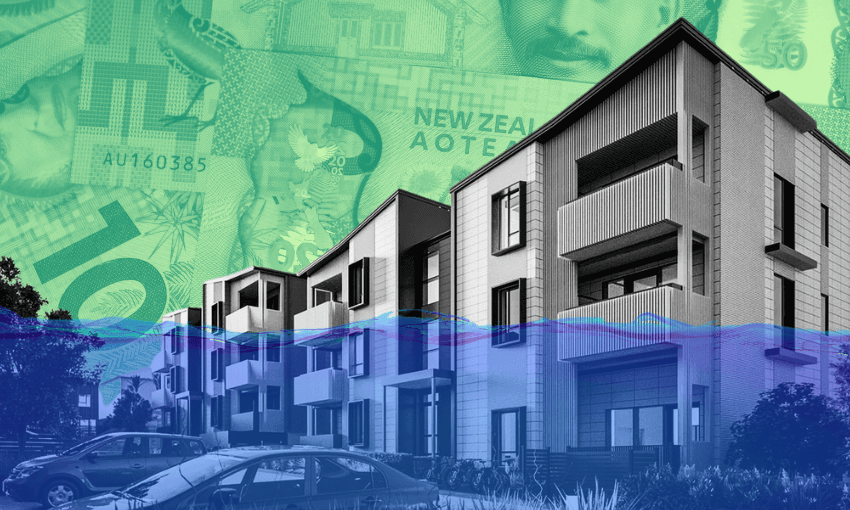Kāinga Ora’s debt problem is serious – but so is the urgent need for more affordable homes, says poverty campaigner Alan Johnson.
As Kāinga Ora cancels projects and sells land previously earmarked for development, it’s clear that two issues are set to dominate the public housing narrative over the next few years. These are the agency’s ballooning debt, and the amount the government spends on building decent homes for poor New Zealanders.
Debt is likely to be the dominant narrative of Sir Bill English’s forthcoming official review of Kāinga Ora’s finances, the release of which was scheduled for late March but has been delayed. This will fit well into the finance minister Nicola Willis’s own preoccupation with getting the government’s books in order and reversing what she sees as the economic recklessness of the previous government.
Kāinga Ora’s debt certainly grew quickly under the political stewardship of Labour. In 2018, shortly before it swept to power, the state housing agency, then know as Housing New Zealand, held relatively modest debt of $2.7 billion. At that time, it owned or managed 64,000 rental housing units. By mid-2023 the organisation now known as Kāinga Ora faced debt of $12.3 billion and had 72,000 dwellings rented as homes or transitional housing units.
In effect these 8,000 extra houses came with an extra debt load of $9.6 billion, or $1.2 million per house. This measure is made worse by the fact that Kāinga Ora already owned the land on which these additional houses were built and the houses themselves were mostly modest apartments or townhouses.
So were the previous government’s efforts to address homelessness a total financial disaster? Before answering that, we should stipulate two things: Kāinga Ora was trying to do more than just build more homes for the poorest New Zealanders, and the debt narrative is based solely on accounting convention.
In 2019, the government set up Kāinga Ora as both a public housing landlord and an urban development agency. As such Kāinga Ora was given a legislative mandate to “go beyond being a social landlord or urban development agency” so as to have “a much larger impact on New Zealand and the quality of New Zealanders’ lives”. For sure, Labour had big ambitions for Kāinga Ora – it just didn’t have an ambition to pay for it.
Kāinga Ora was expected to pursue its ambitious mission with a mix of rental subsidies (known as income-related rent subsidies or IRRS), asset sales and borrowing. This was never a winning combination. The problems were exacerbated by the organisation’s ageing, poorly maintained legacy housing stock and the challenges of redeveloping suburban land that had worn out infrastructure and was often subject to geotechnical limitations and Treaty claims.
Through all of this the Labour government provided Kāinga Ora with just $225 million in extra capital. The government could easily have borrowed $10 billion, provided this to Kāinga Ora as equity capital, and the debt narrative would have disappeared. Of Kāinga Ora’s existing debt, $5 billion is already borrowed from the government, which in turn borrowed it from private money markets. How the capital Kāinga Ora needed was allocated had very little impact on the government’s balance sheet.
The debt issue is certainly problematic, but the asset sales were far worse. As National has pointed out, the briefings it received as the incoming government showed that more than 10,000 state houses would have to be sold off to finance Kāinga Ora’s redevelopment programme. These asset sales had proceeded quietly under Labour. This was often under the guise of a mixed tenure/mixed income model in the redevelopment of suburbs such as Northcote, Mt Roskill and Māngere. Be clear – this is state-sponsored gentrification and will likely continue, perhaps with a different justification, under the present government.
At a time when we need more public housing for those poorest New Zealanders who are being pushed to the margins of the housing market by surging immigration, we are instead likely to get even less. The politics of parsimony and the economics of austerity will prevail and these will deepen the recession that Nicola Willis already appears to be celebrating.
Our homelessness problem is not intractable but it will require a steadfast dedication to just getting on and building more and more social housing – whether through the agency of the state, local government, community organisations, or iwi and hapū. Kāinga Ora was making progress and looked to be achieving an operational scale in redeveloping sites which, over a five- to 10-year period, would have made an appreciable difference. This is being wrecked by a debt narrative that ignores the real social and economic benefits gained from decent affordable housing for the poorest New Zealanders.

